Risk Causal Analysis of Traffic-Intensive Waters Based on Infectious Disease Dynamics
Abstract
1. Introduction
2. Methodology
2.1. Research Framework
2.2. Screening of Risk Factors in Traffic-Intensive Waters
2.2.1. Traffic-Intensive Waters
- (1)
- (2)
- When affected by external factors such as meteorological parameters and hydrological parameters, the possibility of accidents is relatively high [39].
- (3)
- (4)
2.2.2. Risk Factors Affecting Navigation System Safety in Traffic-Intensive Waters
2.2.3. Screening of Key Risk Factors
2.3. Construction of Risk Causal Transmission Analysis Model Based on the Infectious Disease Dynamics Method
2.3.1. Type of Nodes in the Propagation Process of Risk Causing
2.3.2. Conversion Rules of Risk Factor Nodes
- (1)
- The initial nodes of ship navigation in traffic-intensive waters are S: S(k,t), E(k,t), I(k,t), R(k,t).
- (2)
- S(k,t), E(k,t), I(k,t), R(k,t) are characterized as the susceptible node, exposed node, infective node, and removal node of the node degree k in risk causal network of ship navigation at time t, respectively, which satisfy S(k,t) + E(k,t) + I(k,t) + R(k,t) = 1.
- (3)
- The susceptible node spreads to the exposed node E, and the probability that bad weather may occur is Pse in a large traffic flow.
- (4)
- The infective node I receives the stimulus of the exposed node E, and the probability that the tidal node occurs at the infective node is Pei.
- (5)
- The removal node R receives the stimulus from the susceptible node S, the exposed node E, and the infective node I, and the probability that the risk cause occurs is Psr, Per, and Pir, respectively. The risk indicator parameters of ship navigation will stop transmitting at the removal node, which plays an immune role.
2.3.3. Construction of Risk Causal Transmission Model
Per + Psr + Pir = 1,
Pse = Pei + Per,
Pei = Pir.
3. Empirical Case Analysis
3.1. Screening of Key Risk Factors of Ship Navigation
3.1.1. Data Collection of Navigation System Risk Factor
3.1.2. Membership Degree of Key Risk Factors of Navigation
3.2. Evolution of Risk Factor Nodes over Time
3.2.1. Impact of Key Node Density on the Risk Propagation Process
3.2.2. Impact of Ship Traffic Flow on the Risk Propagation Process
3.2.3. Impact of Bad Weather on the Risk Propagation Process
3.2.4. Impact of Tides on the Risk Propagation Process
3.2.5. Impact of Human Errors on the Risk Propagation Process
4. Conclusions
Author Contributions
Funding
Acknowledgments
Conflicts of Interest
References
- Xu, K.J.; Liu, Q.; Xu, L. Research on Continuous Traffic Safety Evaluation of Yangtze River Shipping. Appl. Mech. Mater. 2014, 442, 617–622. [Google Scholar] [CrossRef]
- Hu, S.; Fang, Q.; Xia, H.; Xi, Y. Formal safety assessment based on relative risks model in ship navigation. Reliab. Eng. Syst. Saf. 2007, 92, 369–377. [Google Scholar] [CrossRef]
- Chen, J.; Zhang, C.; Zhang, X.; Zi, Y.; He, S. Planetary gearbox condition monitoring of ship-based satellite communication antennas using ensemble multiwavelet analysis method. Mech. Syst. Signal Process. 2015, 54, 277–292. [Google Scholar] [CrossRef]
- Zhang, D.; Yan, X.P.; Yang, Z.L.; Wall, A.; Wang, J. Incorporation of formal safety assessment and Bayesian network in navigational risk estimation of the Yangtze River. Reliab. Eng. Syst. Saf. 2013, 118, 93–105. [Google Scholar] [CrossRef]
- Wu, B.; Wang, Y.; Zhang, J.; Savan, E.E.; Yan, X. Effectiveness of maritime safety control in different navigation zones using a spatial sequential DEA model: Yangtze River case. Accid. Anal. Prev. 2015, 81, 232–242. [Google Scholar] [CrossRef] [PubMed]
- Wen, Y.; Huang, Y.; Zhou, C.; Yang, J.; Xiao, C.; Wu, X. Modelling of marine traffic flow complexity. Ocean Eng. 2015, 104, 500–510. [Google Scholar] [CrossRef]
- Zhang, D.; Yan, X.; Yang, Z.; Wang, J. An accident data–based approach for congestion risk assessment of inland waterways: A Yangtze River case. Proc. Inst. Mech. Eng. Part O J. Risk Reliab. 2014, 228, 176–188. [Google Scholar] [CrossRef]
- Kappes, M.S.; Keiler, M.; von Elverfeldt, K.; Glade, T. Challenges of analyzing multi-hazard risk: A review. Nat. Hazards 2012, 64, 1925–1958. [Google Scholar] [CrossRef]
- Selva, J. Long-term multi-risk assessment: Statistical treatment of interaction among risks. Nat. Hazards 2013, 67, 701–722. [Google Scholar] [CrossRef]
- Merrick, J.R.W.; van Dorp, J.R.; Blackford, J.P.; Shaw, G.L.; Harrald, J.; Mazzuchi, T.A. A traffic density analysis of proposed ferry service expansion in San Francisco Bay using a maritime simulation model. Reliab. Eng. Syst. Saf. 2003, 81, 119–132. [Google Scholar] [CrossRef]
- Mavrakis, D.; Kontinakis, N. A queueing model of maritime traffic in Bosporus Straits. Simul. Model. Pract. Theory 2008, 16, 315–328. [Google Scholar] [CrossRef]
- Pak, J.; Yeo, G.; Oh, S.; Yang, Z. Port safety evaluation from a captain’s perspective: The Korean experience. Saf. Sci. 2015, 72, 172–181. [Google Scholar] [CrossRef]
- Faghih-Roohi, S.; Xie, M.; Ng, K.M. Accident risk assessment in marine transportation via Markov modelling and Markov Chain Monte Carlo simulation. Ocean Eng. 2014, 91, 363–370. [Google Scholar] [CrossRef]
- Li, D.; Liu, C.; Gan, W. A new cognitive model: Cloud model. Int. J. Intell. Syst. 2009, 24, 357–375. [Google Scholar] [CrossRef]
- Sugumaran, V.; Geetha, T.V.; Manjula, D.; Gopal, H. Guest editorial: Computational intelligence and applications. Inf. Syst. Front. 2017, 19, 969–974. [Google Scholar] [CrossRef][Green Version]
- Kapetanovic, I.M.; Rosenfeld, S.; Izmirlian, G. Overview of commonly used bioinformatics methods and their applications. Ann. N. Y. Acad. Sci. 2004, 1020, 10–21. [Google Scholar] [CrossRef]
- Ma, J.; Zou, C.; Pan, X. Structured probabilistic rough set approximations. Int. J. Approx. Reason. 2017, 90, 319–332. [Google Scholar] [CrossRef]
- Yan, X.P.; Wan, C.P.; Zhang, D.; Yan, Z.L. Safety management of waterway congestions under dynamic risk conditions—A case study of the Yangtze River. Appl. Soft Comput. 2017, 59, 115–128. [Google Scholar] [CrossRef]
- Yu, J.; Wang, L.; Gong, X. Study on the Status Evaluation of Urban Road Intersections Traffic Congestion Base on AHP-TOPSIS Modal. Procedia-Soc. Behav. Sci. 2013, 96, 609–616. [Google Scholar] [CrossRef]
- Liao, H.; Xu, Z.; Zeng, X.J. Hesitant fuzzy linguistic VIKOR method and its application in qualitative multiple criteria decision making. IEEE Trans. Fuzzy Syst. 2014, 23, 1343–1355. [Google Scholar] [CrossRef]
- Liao, H.; Xu, Z. Multi-criteria decision making with intuitionistic fuzzy PROMETHEE. J. Intell. Fuzzy Syst. Appl. Eng. Technol. 2014, 27, 1703–1717. [Google Scholar]
- Montewka, J.; Goerlandt, F.; Kujala, P. On a systematic perspective on risk for formal safety assessment (FSA). Reliab. Eng. Syst. Saf. 2014, 127, 77–85. [Google Scholar] [CrossRef]
- Erol, S.; Başar, E. The analysis of ship accident occurred in Turkish search and rescue area by using decision tree. Marit. Policy Manag. 2015, 42, 377–388. [Google Scholar] [CrossRef]
- Kum, S.; Sahin, B. A root cause analysis for Arctic Marine accidents from 1993 to 2011. Saf. Sci. 2015, 74, 206–220. [Google Scholar] [CrossRef]
- Zhang, M.; Zhang, D.; Goerlandt, F.; Yan, X.; Kujala, P. Use of HFACS and fault tree model for collision risk factors analysis of icebreaker assistance in ice-covered waters. Saf. Sci. 2019, 111, 128–143. [Google Scholar] [CrossRef]
- Hänninen, M. Bayesian networks for maritime traffic accident prevention: Benefits and challenges. Accid. Anal. Prev. 2014, 73, 305–312. [Google Scholar] [CrossRef]
- Chen, K.; Lu, W. Bridging BIM and building (BBB) for information management in construction: The underlying mechanism and implementation. Eng. Constr. Archit. Manag. 2019, 26, 1518–1532. [Google Scholar] [CrossRef]
- Bukhari, A.C.; Tusseyeva, I.; Kim, Y.G. An intelligent real-time multi-vessel collision risk assessment system from VTS view point based on fuzzy inference system. Expert Syst. Appl. 2013, 40, 1220–1230. [Google Scholar] [CrossRef]
- Kao, S.L.; Lee, K.T.; Chang, K.Y.; Ko, M.D. A fuzzy logic method for collision avoidance in vessel traffic service. J. Navig. 2007, 60, 17–31. [Google Scholar] [CrossRef]
- Grinyak, V.M.; Devyatisil’nyi, A.S. Fuzzy collision avoidance system for ships. J. Comput. Syst. Sci. Int. 2016, 55, 249–259. [Google Scholar] [CrossRef]
- Gu, Y.R.; Xia, L.L. The propagation and inhibition of rumors in online social network. Acta Phys. Sin. 2012, 23, 238701. [Google Scholar]
- Liu, Q.M.; Li, T.; Sun, M.C. The analysis of an SEIR rumor propagation model on heterogeneous network. Phys. A Stat. Mech. Appl. 2017, 469, 372–380. [Google Scholar] [CrossRef]
- Kumari, N.; Sharma, S. Modeling the dynamics of infectious disease under the influence of environmental pollution. Int. J. Appl. Comput. Math. 2018, 4, 84. [Google Scholar] [CrossRef]
- Kavousifard, A.; Niknam, T.; Fotuhifiruzabad, M. A novel stochastic framework based on cloud theory and, -modified bat algorithm to solve the distribution feeder reconfiguration. IEEE Trans. Smart Grid. 2016, 7, 740–750. [Google Scholar]
- Lu, J.; Wang, W.; Zhang, Y.; Cheng, S. Multi-objective optimal design of stand-alone hybrid energy system using entropy weight method based on HOMER. Energies 2017, 10, 1664. [Google Scholar] [CrossRef]
- Jiang, D.; Hao, G.; Huang, L.; Zhang, D. Use of cusp catastrophe for risk analysis of navigational environment: A case study of three gorges reservoir area. PLoS ONE 2016, 11, e0158482. [Google Scholar] [CrossRef] [PubMed]
- Zhang, J.; Yan, X.; Zhang, D.; Haugen, S.; Yang, X. Safety management performance assessment for Maritime Safety Administration (MSA) by using generalized belief rule base methodology. Saf. Sci. 2014, 63, 157–167. [Google Scholar] [CrossRef]
- Mou, J.M.; Chen, P.F.; He, Y.X.; Yip, T.L.; Li, W.H.; Tang, J.; Zhang, H.Z. Vessel traffic safety in busy waterways: A case study of accidents in western shenzhen port. Accid. Anal. Prev. 2019, 123, 461–468. [Google Scholar] [CrossRef]
- Kujala, P.; Hänninen, M.; Arola, T.; Ylitalo, J. Analysis of the marine traffic safety in the Gulf of Finland. Reliab. Eng. Syst. Saf. 2009, 94, 1349–1357. [Google Scholar] [CrossRef]
- Yip, T.L. Port traffic risks—A study of accidents in Hong Kong waters. Transp. Res. Part E Logist. Transp. Rev. 2008, 44, 921–931. [Google Scholar]
- Zhang, L.; Meng, Q.; Fwa, T.F. Big AIS data based spatial-temporal analyses of ship traffic in Singapore port waters. Transp. Res. Part E Logist. Transp. Rev. 2017, in press. [Google Scholar] [CrossRef]
- Hidetoshi, M. Safety Management; Japan Industrial Safety and Health Association: Tokyo, Japan, 1966; pp. 98–101.
- Wan, C.; Yang, Z.; Zhang, D.; Yan, X.; Fan, S. Resilience in transportation systems: A systematic review and future directions. Transp. Rev. 2018, 38, 479–498. [Google Scholar] [CrossRef]
- Burmeister, H.C.; Bruhn, W.; Rødseth, Ø.J.; Porathe, T. Autonomous unmanned merchant vessel and its contribution towards the e-Navigation implementation: The MUNIN perspective. Int. J. E-Navig. Marit. Econ. 2014, 1, 1–13. [Google Scholar] [CrossRef]
- Wan, C.; Yan, X.; Zhang, D.; Qu, Z.; Yang, Z. An advanced fuzzy Bayesian-based FMEA approach for assessing maritime supply chain risks. Transp. Res. Part E Logist. Transp. Rev. 2019, 125, 222–240. [Google Scholar] [CrossRef]
- Wahlström, M.; Hakulinen, J.; Karvonen, H.; Lindborg, I. Human factors challenges in unmanned ship operations-insights from other domains. Procedia Manuf. 2015, 3, 1038–1045. [Google Scholar] [CrossRef]
- Rødseth, Ø.J.; Tjora, Å. A risk based approach to the design of unmanned ship control systems. In Maritime-Port Technology and Development; CRC Press: Oxfordshire, UK, 2015; Volume 1, pp. 153–162. [Google Scholar]
- Man, Y.; Lundh, M.; Porathe, T.; MacKinnon, S. From desk to field-human factor issues in remote monitoring and controlling of autonomous unmanned vessels. Procedia Manuf. 2015, 3, 2674–2681. [Google Scholar] [CrossRef]
- Rødseth, Ø.J.; Burmeister, H.C. Risk assessment for an unmanned merchant ship. Int. J. Mar. Navig. Saf. Sea Transp. 2015, 9, 357–364. [Google Scholar] [CrossRef]
- Hogg, T.; Ghosh, S. Autonomous merchant vessels: Examination of factors that impact the effective implementation of unmanned ships. Aust. J. Marit. Ocean Aff. 2016, 8, 206–222. [Google Scholar] [CrossRef]
- Thieme, C.A.; Utne, I.B. Safety performance monitoring of autonomous marine systems. Reliab. Eng. Syst. Saf. 2017, 159, 264–275. [Google Scholar] [CrossRef]
- Zhang, R.L.; Furusho, M. Conversion timing of seafarer’s decision-making for unmanned ship navigation. Int. J. Mar. Navig. Saf. Sea Transp. 2017, 11, 463–468. [Google Scholar] [CrossRef]
- Dan, J.G.; Arnaldos, J.; Darbra, R.M. Introduction of the human factor in the estimation of accident frequencies through fuzzy logic. Saf. Sci. 2017, 97, 134–143. [Google Scholar]
- Wróbel, K.; Montewka, J.; Kujala, P. System-theoretic approach to safety of remotely-controlled merchant vessel. Ocean Eng. 2018, 152, 334–345. [Google Scholar] [CrossRef]
- Wan, C.; Yang, X.; Zhang, D.; Yang, Z. A novel model for quantitative of green port development-a case study of major ports in China. Transp. Res. Part D Transp. Environ. 2018, 61, 431–443. [Google Scholar] [CrossRef]
- Hontvedt, M. Professional vision in simulated environments-examining professional maritime pilots’ performance of work tasks in a full-mission ship simulator. Learn. Cult. Social Interact. 2015, 7, 71–84. [Google Scholar] [CrossRef]
- Lazakis, I.; Dikis, K.; Michala, A.L.; Theotokatos, G. Advancedship systems condition monitoring for enhanced inspection maintenance and decision making in ship operations. Transp. Res. Procedia 2016, 14, 1679–1688. [Google Scholar] [CrossRef]
- Wróbel, K.; Montewka, J.; Kujala, P. Towards the assessment of potential impact of unmanned vessels on maritime transportation safety. Reliab. Eng. Syst. Saf. 2017, 165, 155–169. [Google Scholar] [CrossRef]
- Ahvenjärvi, S. The Human Element and Autonomous Ships. Int. J. Mar. Navig. Saf. Sea Transp. 2016, 10, 517–521. [Google Scholar] [CrossRef]
- Zadeh, L.A. Fuzzy sets. Inf. Control. 1965, 8, 338–353. [Google Scholar] [CrossRef]
- Feng, Z.; Thieme, H.R. Endemic models with arbitrarily distributed periods of infection I: Fundamental properties of the model. SIAM J. Appl. Math. 2000, 61, 803–833. [Google Scholar] [CrossRef]
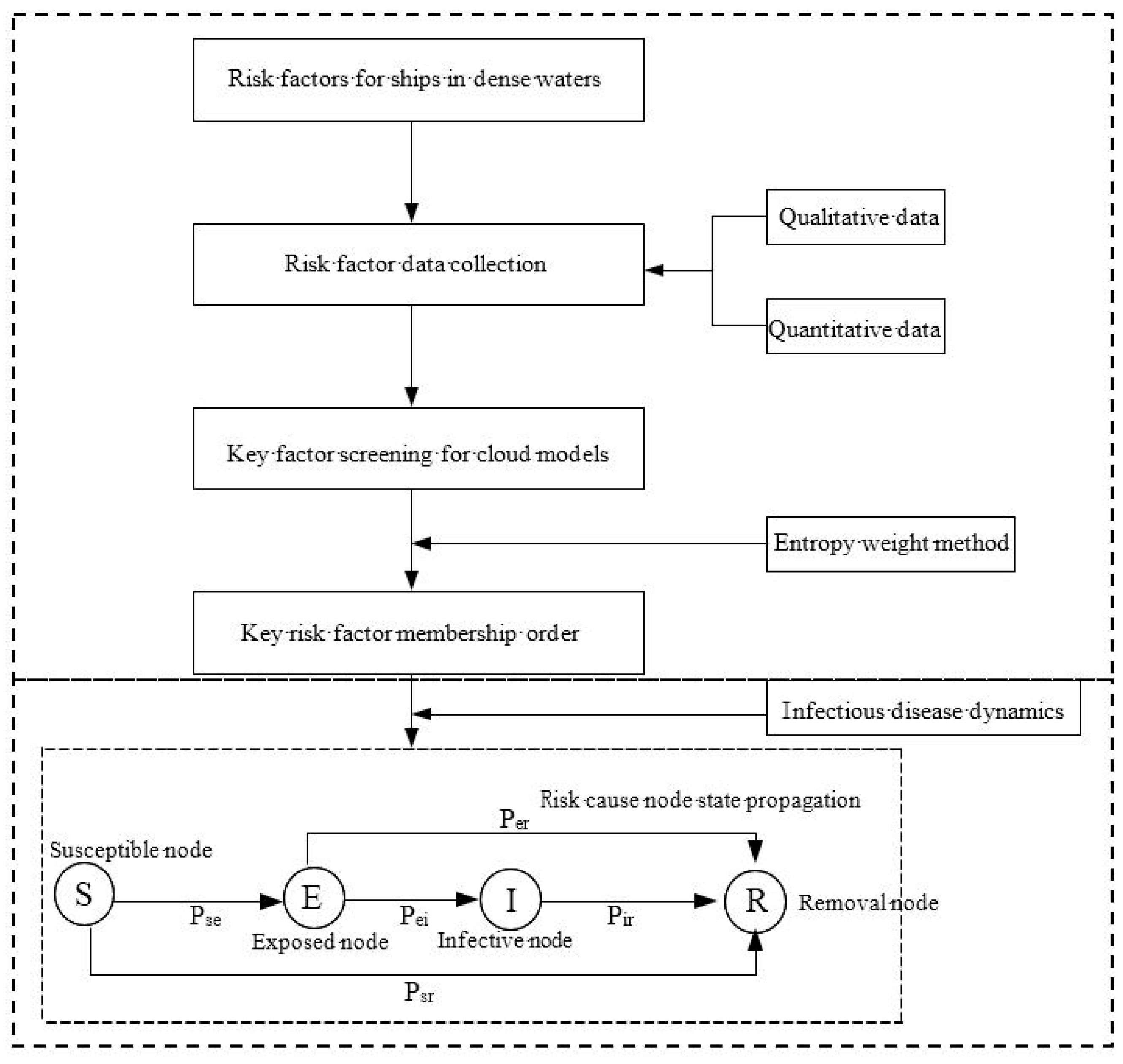
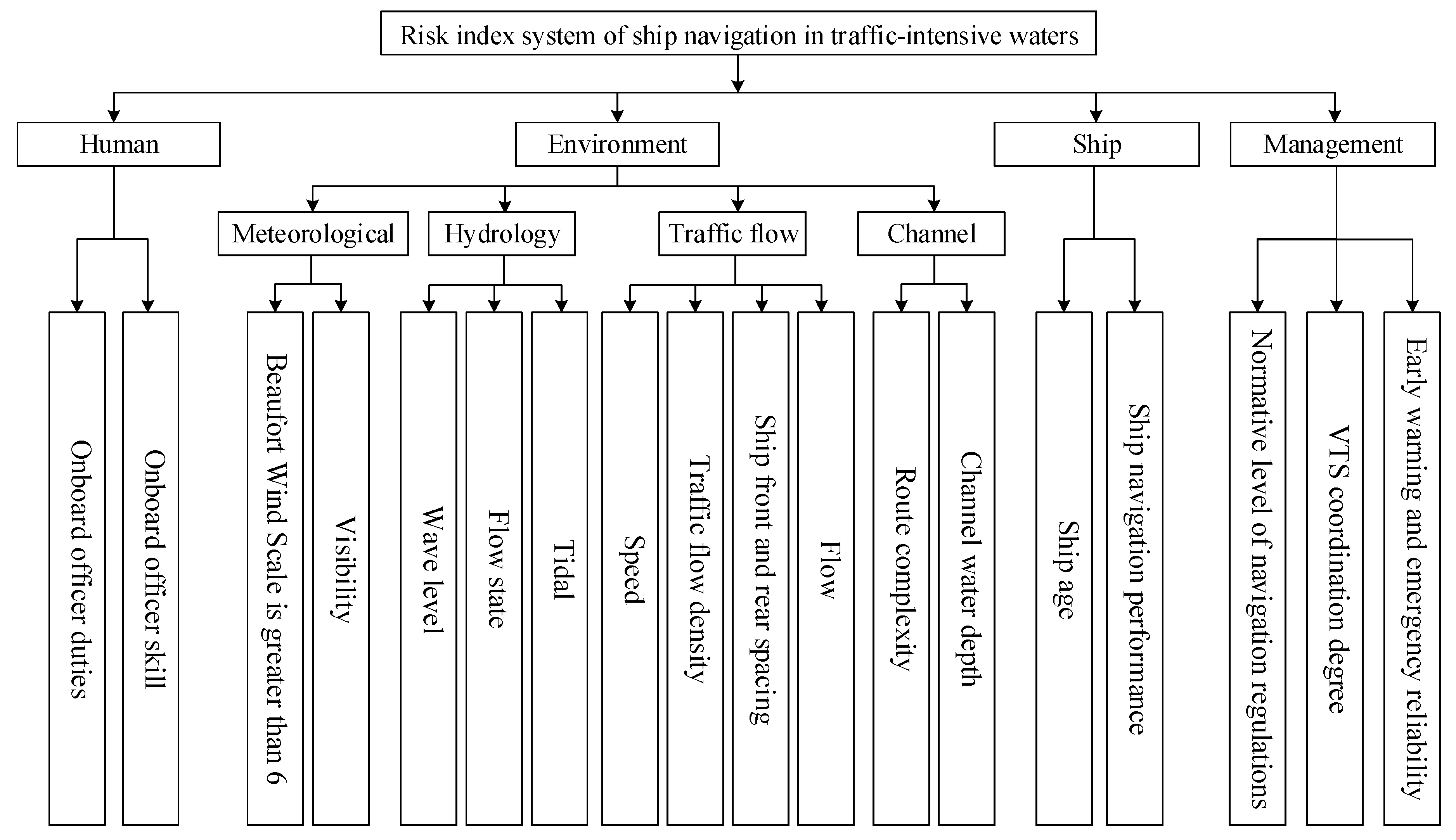

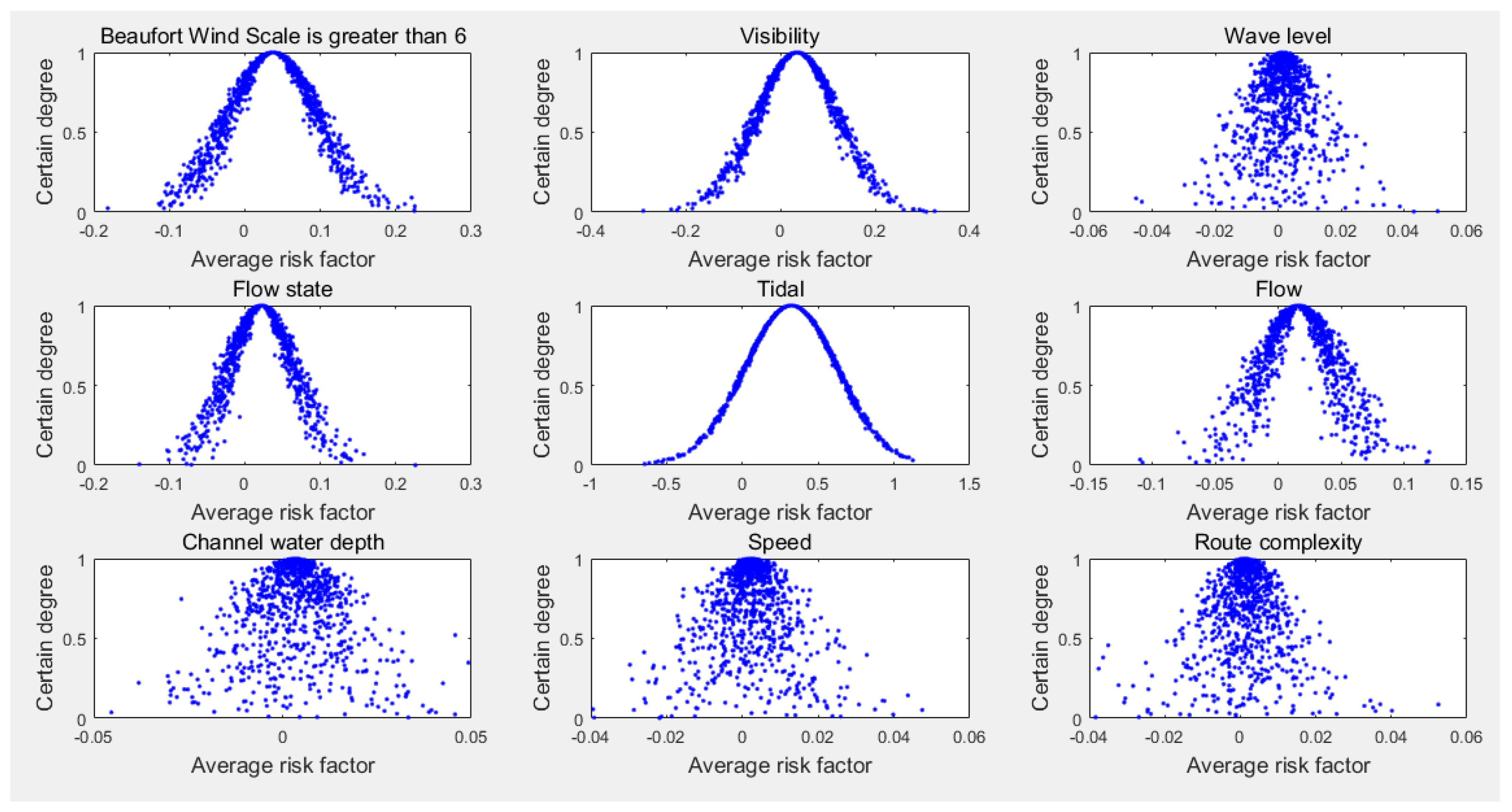
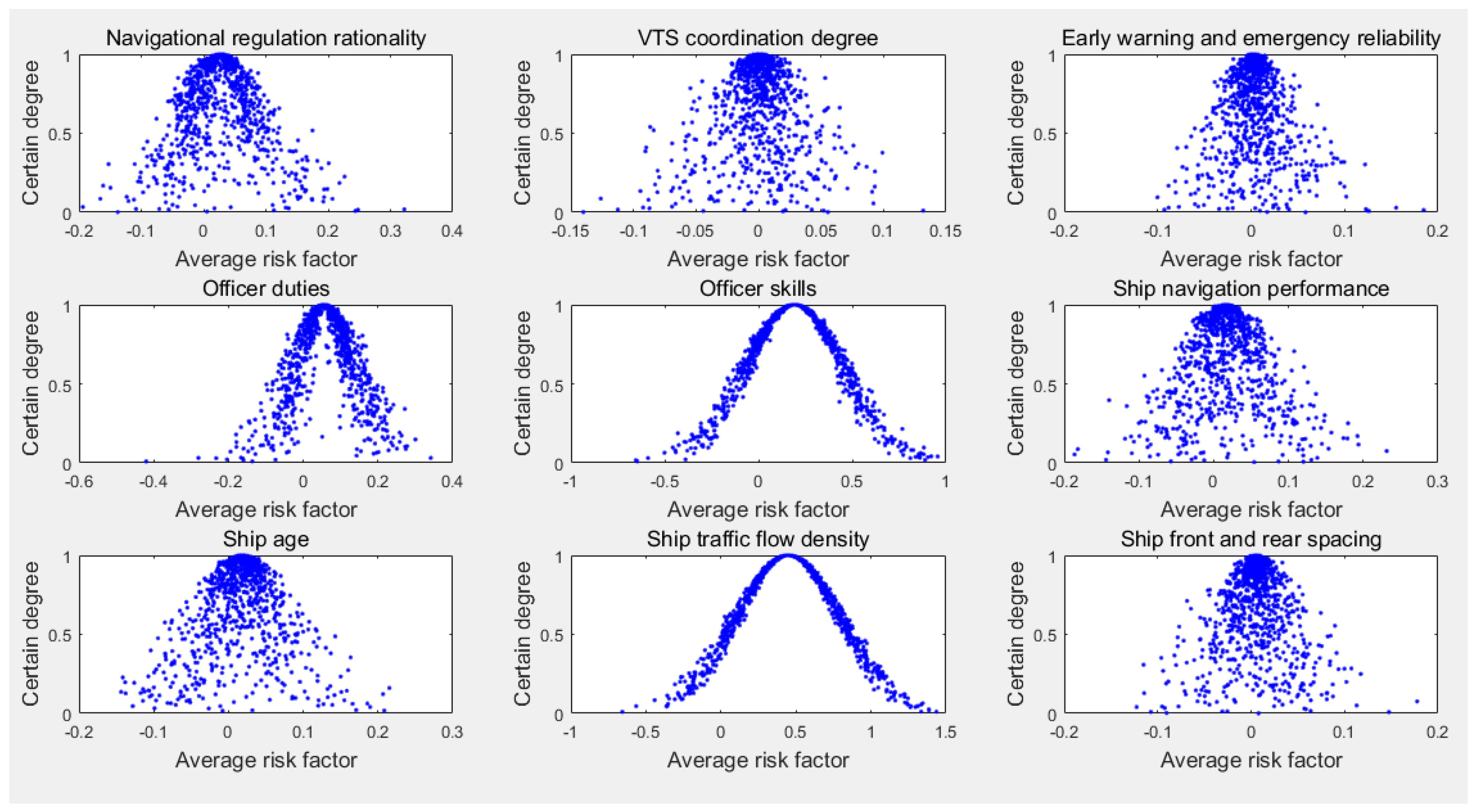
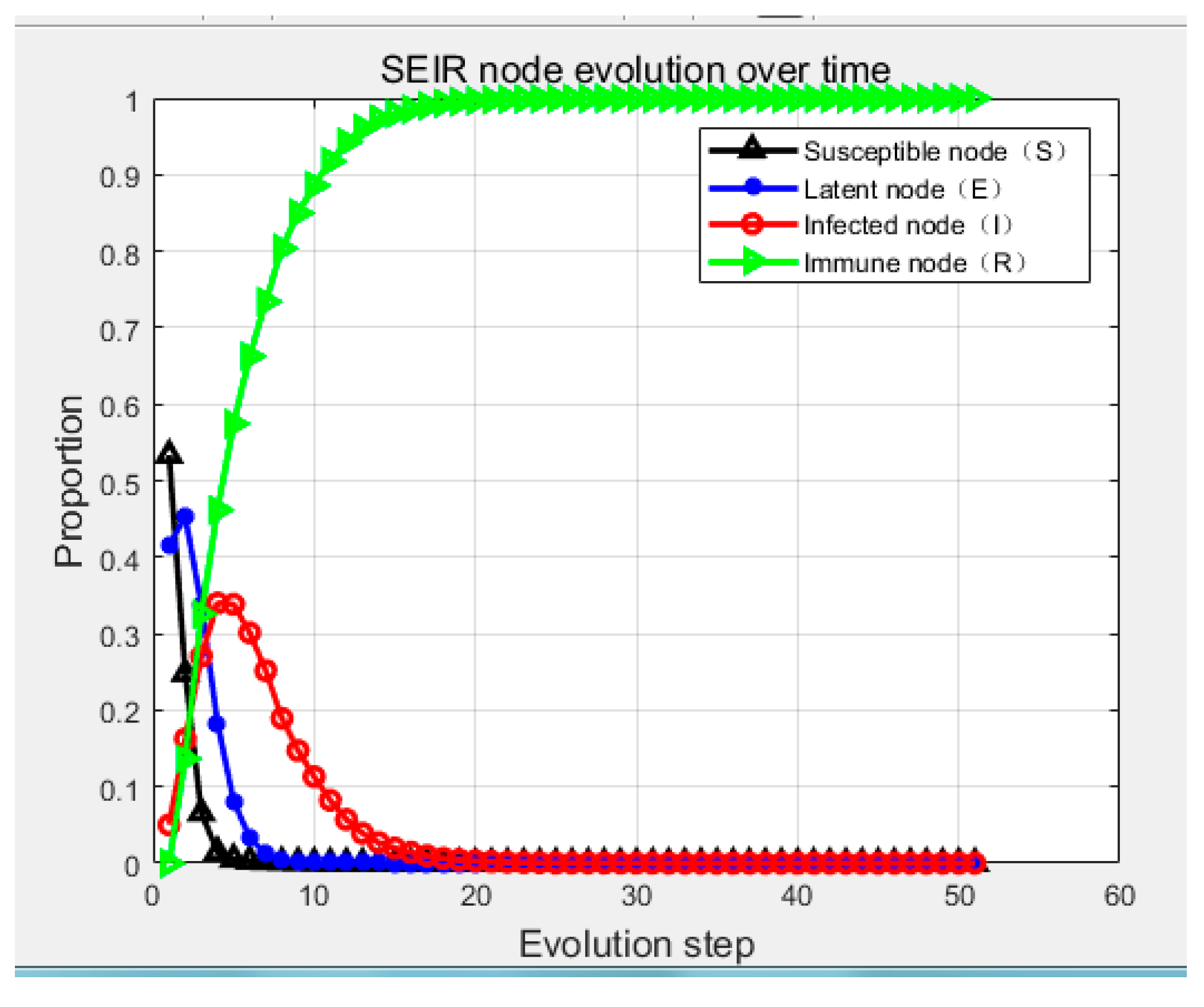
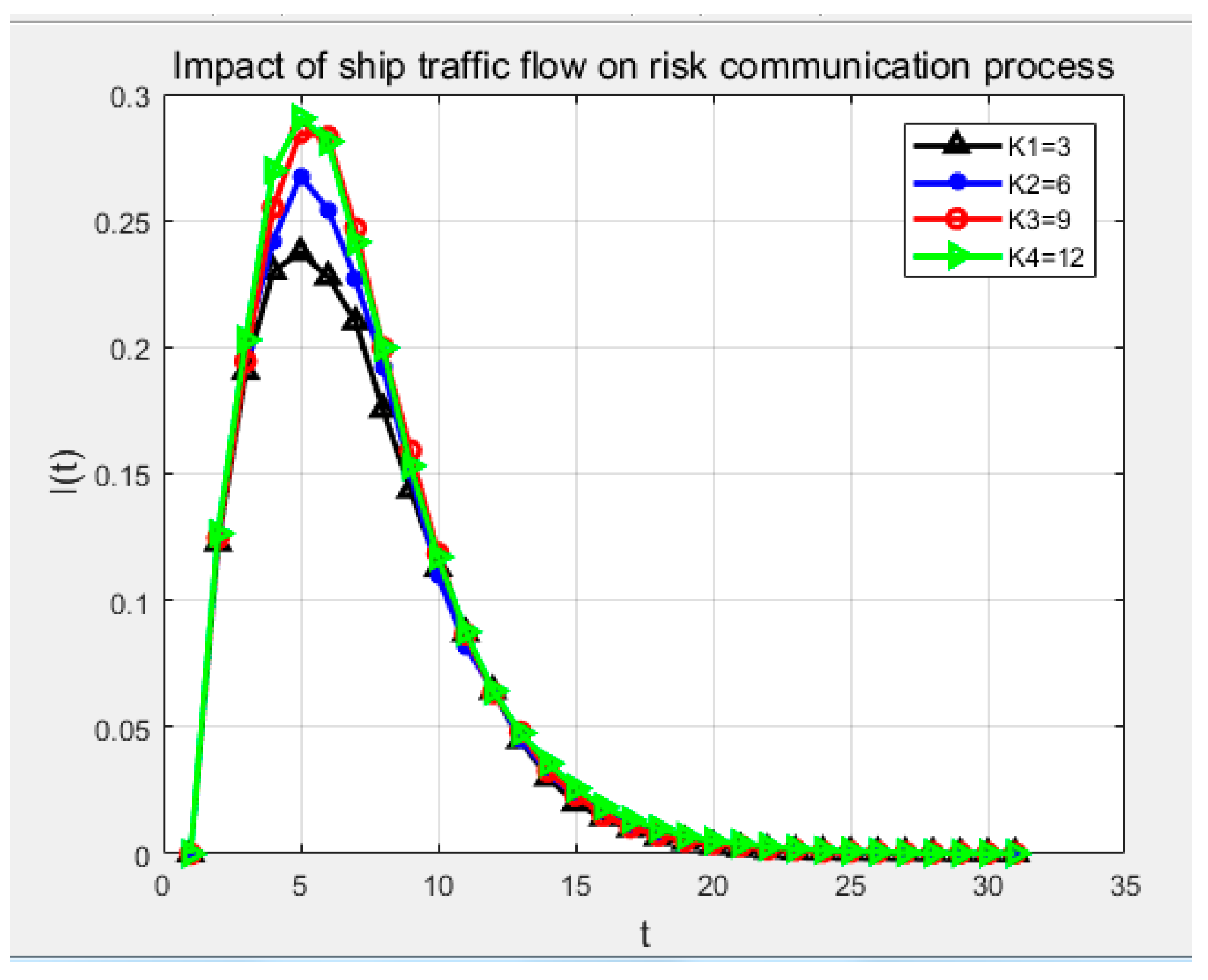
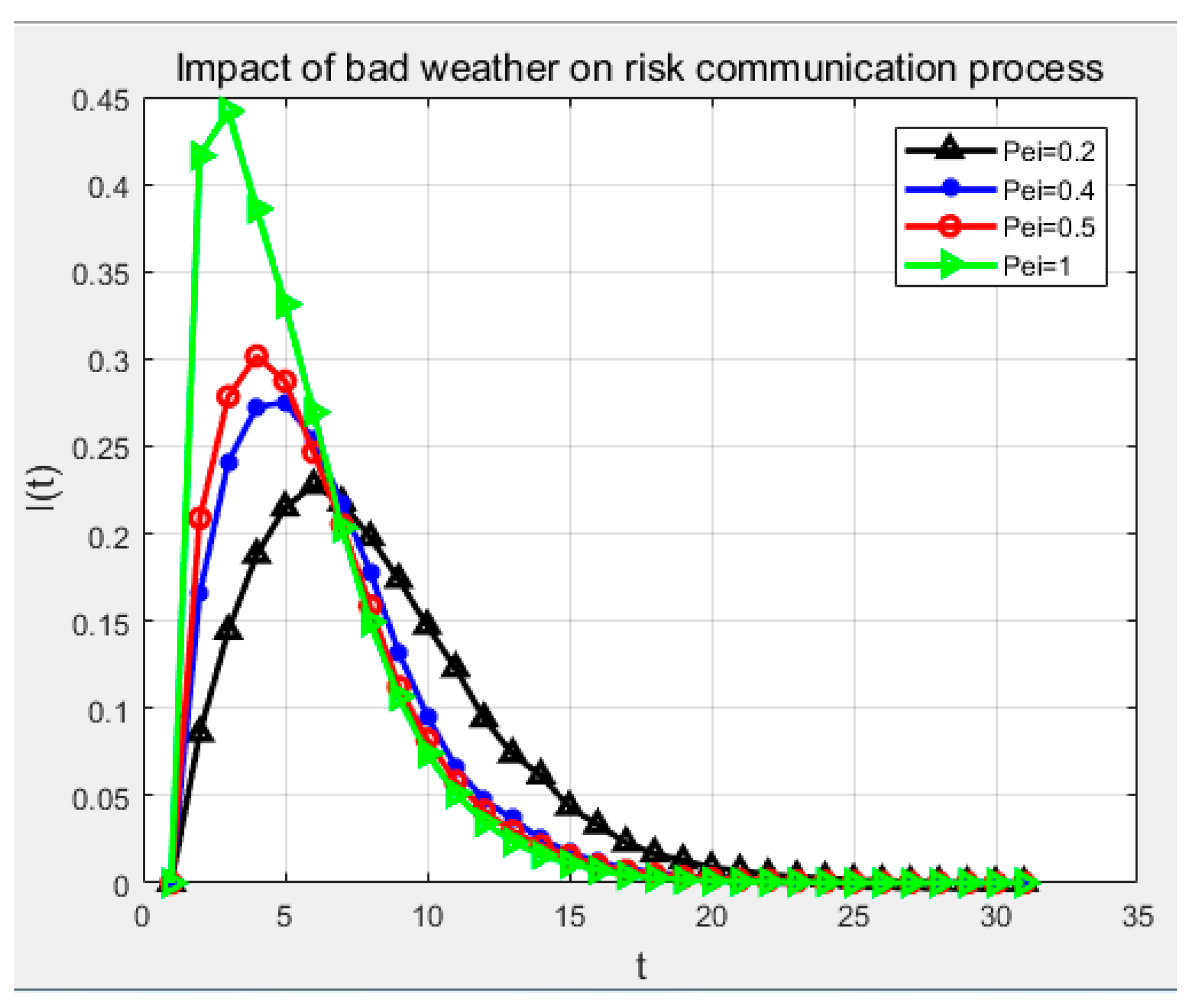
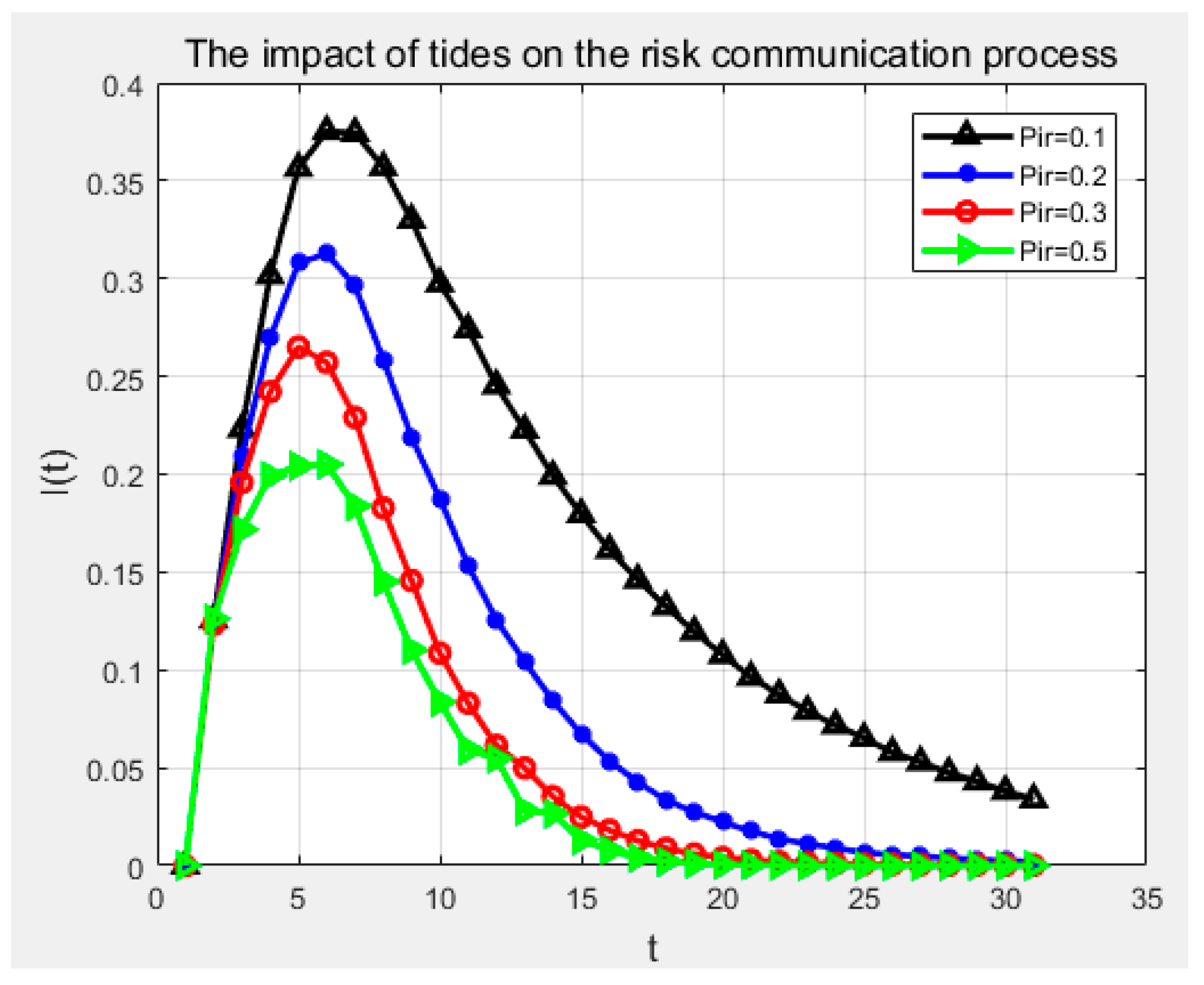
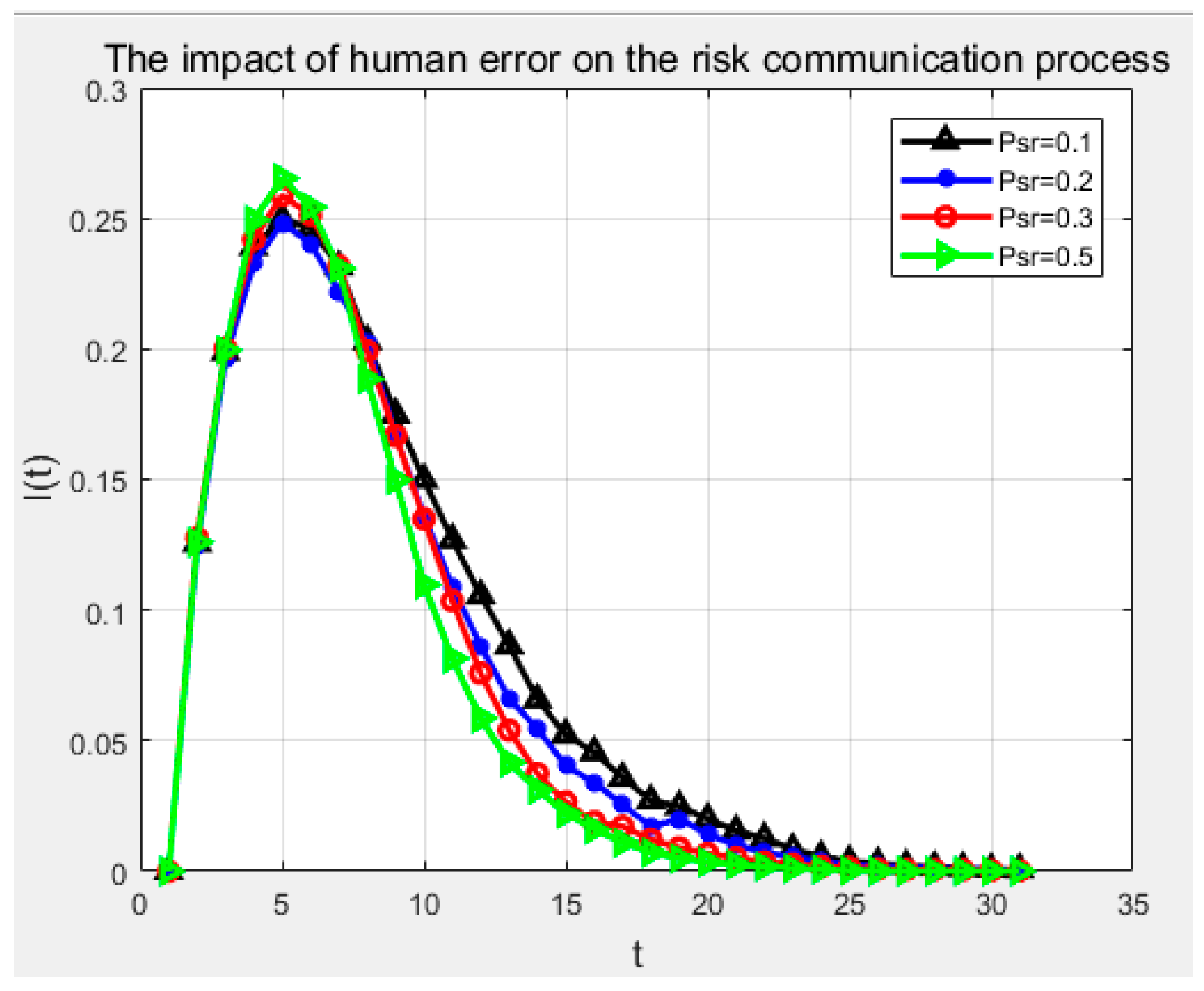
| Categories | Factors | Reference |
|---|---|---|
| Human | Office duties, office skills | Wan et al. [43], Burmeister et al. [44], Wan et al. [45], Wahlström et al. [46], Rødseth and Tjora [47], Man et al. [48], Rødseth and Burmeister [49], Hogg and Ghosh [50], Thieme and Utne [51], Zhang and Furusho [52], Dan et al. [53], Wróbel et al. [54], Wan et al. [55]. |
| Environment | Meteorology, hydrology, navigation channel, and traffic flow | Wan et al. [43], Wan et al. [45], Rødseth and Tjora [47], Wan et al. [55], Hontvedt [56]. |
| Ship | Ship age, ship navigation performance | Wan et al. [43], Wan et al. [45], Rødseth and Tjora [47], Rødseth and Burmeister [49], Zhang and Furusho [52], Dan et al. [53], Hogg and Ghosh [50], Lazakis et al. [57], Wróbel et al. [58]. |
| Management | Navigation rationality regulations, VTS (vessel traffic service) coordination degree, early warning and emergency reliability | Wan et al. [43], Burmeister et al. [44], Rødseth and Tjora [47], Man et al. [48], Rødseth and Burmeister [49], Wan et al. [55], Ghosh [55], Ahvenjärvi [59]. |
| Month | 1 | 2 | 3 | 4 | 5 | 6 | 7 | 8 | 9 | 10 | 11 | 12 |
|---|---|---|---|---|---|---|---|---|---|---|---|---|
| Poor visibility days | 2 | 0 | 0 | 5 | 3 | 0 | 1 | 1 | 1 | 1 | 4 | 0 |
| Beaufort wind scale is greater than 6 | 14 | 13 | 11 | 12 | 11 | 6 | 10 | 20 | 10 | 11 | 11 | 8 |
| Number of large tidal range | 31 | 28 | 30 | 30 | 31 | 30 | 31 | 30 | 30 | 31 | 30 | 31 |
| Type of Risk Factors | Risk Factors | Quantity | Frequency |
|---|---|---|---|
| Environment | Wave level | 30 | 0.2678 |
| Flow state | 25 | 0.2232 | |
| Traffic flow density | 75 | 0.6696 | |
| Flow | 33 | 0.2946 | |
| Channel water depth | 3 | 0.0268 | |
| Speed | 3 | 0.0268 | |
| Route complexity | 3 | 0.0268 | |
| Ship front and rear spacing | 5 | 0.0446 | |
| Management | Navigation regulation rationality | 35 | 0.3125 |
| VTS (vessel traffic service) coordination degree | 2 | 0.0179 | |
| Early warning and emergency reliability | 10 | 0.0893 | |
| Human | Onboard officer duties | 50 | 0.4464 |
| Onboard officer skill | 51 | 0.4554 | |
| Ship | Ship age | 15 | 0.1340 |
| Ship navigation performance | 21 | 0.1875 |
| Variable | Description | Frequency | Percentage (n = 982): % |
|---|---|---|---|
| Occupation | Professor | 20 | 2.03 |
| Research assistant | 45 | 4.58 | |
| Associate professor | 55 | 5.60 | |
| Captain | 90 | 9.16 | |
| Chief officer | 90 | 9.16 | |
| Second officer | 130 | 13.24 | |
| Third officer | 120 | 12.22 | |
| Sea pilot | 160 | 16.30 | |
| Shipping company manager | 155 | 15.79 | |
| Maritime organizations | 117 | 11.92 | |
| Education level | Doctor | 60 | 6.11 |
| Master | 140 | 14.26 | |
| Bachelor | 782 | 79.63 |
| Risk Source | The Probability of Risk Occurrence P | Risk Factor Influence Degree I |
|---|---|---|
| Beaufort wind scale is greater than 6 | 0.3753 | 0.101 |
| Visibility | 0.0411 | 0.851 |
| Wave level | 0.2678 | 0.005 |
| Flow state | 0.2232 | 0.102 |
| Tidal | 0.5893 | 0.521 |
| Flow | 0.2946 | 0.057 |
| Channel water depth | 0.0268 | 0.098 |
| Speed | 0.0268 | 0.075 |
| Route complexity | 0.0268 | 0.054 |
| Navigational regulation rationality | 0.3125 | 0.094 |
| VTS coordination degree | 0.0179 | 0.065 |
| Early warning and emergency reliability | 0.0893 | 0.032 |
| Onboard officer duties | 0.4464 | 0.125 |
| Onboard officer skill | 0.4554 | 0.421 |
| Ship navigation performance | 0.1875 | 0.098 |
| Ship age | 0.1340 | 0.125 |
| Ship traffic flow density | 0.6696 | 0.651 |
| Ship front and rear spacing | 0.0446 | 0.158 |
| Cloud Parameter | 1 | 2 | 3 |
|---|---|---|---|
| Beaufort wind scale is greater than 6 | 0.0365 | 0.0584 | 0.0325 |
| Visibility | 0.0400 | 0.0955 | 0.1528 |
| Wave level | 0.0013 | 0.0024 | 0.0009 |
| Flow state | 0.0224 | 0.0439 | 0.0117 |
| Tidal | 0.3079 | 0.3157 | 0.1843 |
| Flow | 0.0168 | 0.0297 | 0.0144 |
| Channel water depth | 0.0026 | 0.0065 | 0.0145 |
| Speed | 0.0016 | 0.0039 | 0.0100 |
| Route complexity | 0.0012 | 0.0030 | 0.0075 |
| Navigational regulation rationality | 0.0304 | 0.0515 | 0.0268 |
| VTS coordination degree | 0.0010 | 0.0026 | 0.0077 |
| Early warning and emergency reliability | 0.0028 | 0.0063 | 0.0064 |
| Onboard officer duties | 0.0559 | 0.0775 | 0.0462 |
| Onboard officer skill | 0.1831 | 0.2594 | 0.1538 |
| Ship navigation performance | 0.0185 | 0.0377 | 0.0075 |
| Ship age | 0.0169 | 0.0366 | 0.0221 |
| Ship traffic flow density | 0.4375 | 0.3597 | 0.1894 |
| Ship front and rear spacing | 0.0090 | 0.0213 | 0.0298 |
© 2019 by the authors. Licensee MDPI, Basel, Switzerland. This article is an open access article distributed under the terms and conditions of the Creative Commons Attribution (CC BY) license (http://creativecommons.org/licenses/by/4.0/).
Share and Cite
Chen, Y.-j.; Liu, Q.; Wan, C.-p. Risk Causal Analysis of Traffic-Intensive Waters Based on Infectious Disease Dynamics. J. Mar. Sci. Eng. 2019, 7, 277. https://doi.org/10.3390/jmse7080277
Chen Y-j, Liu Q, Wan C-p. Risk Causal Analysis of Traffic-Intensive Waters Based on Infectious Disease Dynamics. Journal of Marine Science and Engineering. 2019; 7(8):277. https://doi.org/10.3390/jmse7080277
Chicago/Turabian StyleChen, Yong-jun, Qing Liu, and Cheng-peng Wan. 2019. "Risk Causal Analysis of Traffic-Intensive Waters Based on Infectious Disease Dynamics" Journal of Marine Science and Engineering 7, no. 8: 277. https://doi.org/10.3390/jmse7080277
APA StyleChen, Y.-j., Liu, Q., & Wan, C.-p. (2019). Risk Causal Analysis of Traffic-Intensive Waters Based on Infectious Disease Dynamics. Journal of Marine Science and Engineering, 7(8), 277. https://doi.org/10.3390/jmse7080277





